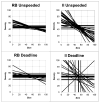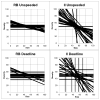The time course of explicit and implicit categorization
- PMID: 26025556
- PMCID: PMC4607559
- DOI: 10.3758/s13414-015-0933-2
The time course of explicit and implicit categorization
Abstract
Contemporary theory in cognitive neuroscience distinguishes, among the processes and utilities that serve categorization, explicit and implicit systems of category learning that learn, respectively, category rules by active hypothesis testing or adaptive behaviors by association and reinforcement. Little is known about the time course of categorization within these systems. Accordingly, the present experiments contrasted tasks that fostered explicit categorization (because they had a one-dimensional, rule-based solution) or implicit categorization (because they had a two-dimensional, information-integration solution). In Experiment 1, participants learned categories under unspeeded or speeded conditions. In Experiment 2, they applied previously trained category knowledge under unspeeded or speeded conditions. Speeded conditions selectively impaired implicit category learning and implicit mature categorization. These results illuminate the processing dynamics of explicit/implicit categorization.
Keywords: Category learning; Cognitive neuroscience; Explicit cognition; Implicit cognition; Response deadlines.
Figures








References
-
- Ahn WK, Medin DL. A two-stage model of category construction. Cognitive Science. 1992;16:81–121.
-
- Aschkenasy JR, Odom RD. Classification and perceptual development: Exploring issues about integrality and differential sensitivity. Journal of Experimental Child Psychology. 1982;34:435–448. - PubMed
-
- Ashby FG, Alfonso-Reese LA. Categorization as probability density estimation. Journal of mathematical psychology. 1995;39:216–233.
-
- Ashby FG, Alfonso-Reese LA, Turken AU, Waldron EM. A neuropsychological theory of multiple systems in category learning. Psychological Review. 1998;105:442–481. - PubMed
Publication types
MeSH terms
Grants and funding
LinkOut - more resources
Full Text Sources
Other Literature Sources

